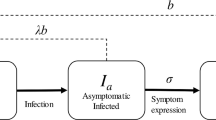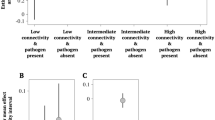Abstract
For an epidemic to occur in a closed population, the transmission rate must be above a threshold level. In plant populations, the threshold depends not only on host density, but on the distribution of hosts in space. This paper presents an alternative analysis of a previously presented stochastic model for an epidemic in continuous space (Bolker, 1999, Bull. Math. Biol. 61, 849–874). A variety of moment closures are investigated to determine the dependence of the epidemic threshold on host spatial distribution and pathogen dispersal. Local correlations that arise during the early phase of the outbreak determine whether a true global epidemic will occur.
Similar content being viewed by others
References
Ackermann, R. V. and R. W. Schlische (1997). Anticlustering of small normal faults around larger faults. Geology 25, 1127–1130.
Alexander, H. M. (1989). Spatial heterogeneity and disease in natural plant populations, in Spatial Components of Plant Disease Epidemics, M. J. Jeger (Ed.), Englewood Cliffs: Prentice Hall.
Anderson, R. M. (1991). Discussion: The Kermack-McKendrick epidemic threshold theorem. Bull. Math. Biol. 53, 3–32.
Augspurger, C. K. (1984). Seedling survival of tropical tree species: interactions of dispersal distance, light gaps, and pathogens. Ecology 65, 1705–1712.
Aylor, D. E. (1989). Aerial spore dispersal close to a focus of disease. Agr. Forest Meteorol. 47, 109–122.
Bergelson, J., J. A. Newman and E. M. Floresroux (1993). Rates of weed spread in spatially heterogeneous environments. Ecology 74, 999–1011.
Bohan, D. A., A. C. Bohan, D. M. Glen, W. O. C. Symondson, C. W. Wiltshire and L. Hughes (2000). Spatial dynamics of predation by carabid beetles on slugs. J. Anim. Ecol. 69, 267–379.
Bolker, B. M. (1999). Analytic models for the patchy spread of plant disease. Bull. Math. Biol. 61, 849–874.
Bolker, B. M. and S. W. Pacala (1997). Using moment equations to understand stochastically driven spatial pattern formation in ecological systems. Theor. Popul. Biol. 52, 179–197.
Bolker, B. M. and S. W. Pacala (1999). Spatial moment equations for plant competition: understanding spatial strategies and the advantages of short dispersal. Am. Nat. 153, 575–602.
Brophy, L. S. and C. C. Mundt (1991). Influence of plant spatial patterns on disease dynamics, plant competition and grain yield in genetically diverse wheat populations. Agr. Ecosyst. Environ. 35, 1–12.
Burdon, J. J. and G. A. Chilvers (1976). The effect of clumped planting patterns on epidemics of damping-off disease in cress seedlings. Oecologia 23, 17–29.
Carlsson, U. and T. Elmqvist (1992). Epidemiology of anther-smut disease Microbotryum violaceum and numeric regulation of population of Silene dioica. Oecologia 90, 509–517.
Carlsson, U., T. Elmqvist, A. Wennstrom and L. Ericson (1990). Infection by pathogens and population age of host plants. J. Ecol. 78, 1094–1105.
Cole, B. J., K. Haight and D. C. Wiernasz (2001). Distribution of Myrmecocystus mexicanus (Hymenoptera: Formicidae): Association with Pogonomyrmex occidentalis (Hymenoptera: Formicidae). Ann. Entomol. Soc. Am. 94, 59–63.
Cressie, N. A. C. (1991). Statistics for Spatial Data, New York: Wiley.
Dale, M. R. T., P. Dixon, M.-J. Fortin, P. Legendre, D. E. Myers and M. S. Rosenberg (2002). Conceptual and mathematical relationships among methods for spatial analysis. Ecography 25, 558–577.
Diekmann, O. (1978). Thresholds and travelling waves for the geographical spread of infection. J. Math. Biol. 6, 109–130.
Diekmann, O., J. A. P. Heesterbeek and J. A. J. Metz (1990). On the definition and the computation of the basic reproduction ratio R 0 in models for infectious diseases in heterogeneous populations. J. Math. Biol. 28, 365–382.
Dieckmann, U. and R. Law (2000). Relaxation projections and the method of moments, in The Geometry of Ecological Interactions: Simplifying Spatial Complexity, U. Dieckmann, R. Law and J. A. J. Metz (Eds), Cambridge: Cambridge University Press.
Diggle, P. (1983). Statistical Analysis of Spatial Point Patterns, New York: Academic Press.
Durrett, R. (1995). Spatial epidemic models, in Epidemic Models: Their Structure and Relation to Data, D. Mollison (Ed.), Cambridge: Cambridge University Press.
Durrett, R. and S. A. Levin (1994). The importance of being discrete (and spatial). Theor. Popul. Biol. 46, 363–394.
Filipe, J. A. N. and G. J. Gibson (1998). Studying and approximating spatio-temporal models for epidemic spread and control. Philos. Trans. R. Soc. Lond. B 353, 2153–2162.
Filipe, J. A. N. and G. J. Gibson (2001). Comparing approximations to spatio-temporal models for epidemics with local spread. Bull. Math. Biol. 63, 603–624.
Fry, N. (1979). Random point distributions and strain measurement in rocks. Tectonophysics 60, 89–105.
Gubbins, S., C. A. Gilligan and A. Kleczkowski (2000). Population dynamics of plant-parasite interactions: Thresholds for invasion. Theor. Popul. Biol. 57, 219–233.
Guttorp, P., D. R. Brillinger and F. P. Schoenberg (2002). Point processes, spatial, in Encyclopedia of Environmetrics, Vol. 3, A. H. El-Shaarawi and W. W. Piegorsch (Eds), Chichester: Wiley and Sons.
Holmes, E. (1997). Basic epidemiological concepts in a spatial context, in Spatial Ecology: The Role of Space in Population Dynamics and Interspecific Interactions, D. Tilman and P. Kareiva (Eds), Princeton: Princeton University Press.
Jeger, M. J. (1986). Asymptotic behaviour and threshold criteria in model plant disease epidemics. Plant Pathol. 35, 355–361.
Jeger, M. J. (Ed.), (1989). Spatial Components of Plant Disease Epidemics, Englewood Cliffs: Prentice Hall.
Jeger, M. J. and F. van den Bosch (1994). Threshold criteria for model plant disease epidemics. I. Asymptotic results. Phytopathology 84, 24–27.
Keeling, M. J. (1999). The effects of local spatial structure on epidemiological invasions. Philos. R. Soc. Lond. B 266, 859–867.
Keeling, M. J. and B. T. Grenfell (2000). Individual-based perspectives on R 0. J. Theor. Biol. 203, 51–61.
Kendall, D. G. (1957). Discussion of ‘Measles periodicity and community size’ by M. S. Bartlett. J. R. Stat. Soc. A 120, 48–70.
Kermack, W. O. and A. G. McKendrick (1927). A contribution to the mathematical theory of epidemics. Philos. R. Soc. Lond. A 115, 700–721.
Kleczkowski, A. and B. T. Grenfell (1999). Mean-field-type equations for spread of epidemic: the ’small world’ model. Physica A 274, 355–360.
Kot, M., M. A. Lewis and P. van den Driessche (1996). Dispersal data and the spread of invading organisms. Ecology 77, 2027–2042.
Law, R. and U. Dieckmann (2000). Moment approximations of individual-based models, in The Geometry of Ecological Interactions: Simplifying Spatial Complexity, U. Dieckmann, R. Law and J. A. J. Metz (Eds), Cambridge: Cambridge University Press.
Levin, S. A. and R. Durrett (1996). From individuals to epidemics. Philos. Trans. R. Soc. Lond. B 351, 1615–1621.
Lewis, M. A. and S. Pacala (2000). Modeling and analysis of stochastic invasion processes. J. Math. Biol. 41, 387–429.
Madden, L. V., M. J. Jeger and F. van den Bosch (2000). A theoretical assessment of the effects of vector-virus transmission on plant virus disease epidemics. Phytopathology 90, 576–594.
Matsuda, H., N. Ogita, A. Sasaki and K. Sato (1992). Statistical mechanics of population. Prog. Theor. Phys. 88, 1035–1049.
May, R. M. (1990). Population biology and population genetics of plant-pathogen associations, in Pests, Pathogens and Plant Communities, J. J. Burdon and S. R. Leather (Eds), Oxford: Blackwell Scientific.
May, R. M. and R. M. Anderson (1989). The transmission dynamics of human immunodeficiency virus (HIV), in Applied Mathematical Ecology, S. A. Levin, T. G. Hallam and L. J. Gross (Eds), Berlin: Springer.
McCallum, H., N. Barlow and J. Hone (2001). How should pathogen transmission be modelled? TREE 16, 295–300.
McCartney, H. A. and B. D. L. Fitt (1987). Spore dispersal gradients and disease development, in Populations of Plant Pathogens: Their Dynamics and Genetics, M. S. Wolfe and C. E. Caten (Eds), Oxford: Blackwell Scientific.
McElhany, P., L. Real and A. Power (1995). Vector preference and disease dynamics: A study of barley yellow dwarf virus. Ecology 76, 444–457.
Metz, J. A. J. and F. van den Bosch (1995). Velocities of epidemic spread, in Epidemic Models: Their Structure and Relation to Data, D. Mollison (Ed.), Cambridge: Cambridge University Press.
Minogue, K. P. (1989). Diffusion and spatial probability models for disease spread, in Spatial Components of Plant Disease Epidemics, M. J. Jeger (Ed.), Englewood Cliffs: Prentice Hall.
Mundt, C. C. (1989). Modeling disease increase in host mixtures, in Plant Disease Epidemiology, Vol. II, K. J. Leonard and W. Fry (Eds), New York: McGraw-Hill.
Mundt, C. C. and J. A. Browning (1985). Development of crown rust epidemics in genetically diverse host populations: Effect of genotype unit area. Phytopathology 75, 607–610.
Nasell, I. (1995). The threshold concept in deterministic and stochastic models, in Epidemic Models: Their Structure and Relation to Data, D. Mollison (Ed.), Cambridge: Cambridge University Press.
Onstad, D. W. (1992). Evaluation of epidemiological thresholds and asymptotes with variable plant densities. Phytopathology 82, 1028–1032.
Ramsay, J. G. and M. I. Huber (1983). The Techniques of Modern Structural Analysis, vol. 1, London: Academic Press.
Real, L. A. and P. McElhany (1996). Spatial pattern and process in plant-pathogen interactions. Ecology 77, 1011–1025.
San Jose, J. J., M. R. Farinas and J. Rosales (1991). Spatial patterns of trees and structuring factors in a Trachypogon savanna of the Orinoco Llanos. Biotropica 23, 114–123.
Sato, K., H. Matsuda and A. Sasaki (1994). Pathogen invasion and host extinction in lattice structured populations. J. Math. Biol. 32, 251–268.
Thieme, H. R. (1977). A model for the spatial spread of an epidemic. J. Math. Biol. 4, 337–351.
Thrall, P. H. and J. J. Burdon (1997). Host-pathogen dynamics in a metapopulation context: The ecological and evolutionary consequences of being spatial. J. Ecology 85, 743–753.
Thrall, P. H. and J. J. Burdon (1999). The spatial scale of pathogen dispersal: Consequences for disease dynamics and persistence. Evol. Ecol. Res. 1, 681–701.
Watve, M. G. and M. M. Jog (1997). Epidemic diseases and host clustering: An optimum cluster size ensures maximum survival. J. Theor. Biol. 184, 165–169.
Wright, S. (1946). Isolation by distance under diverse systems of mating. Genetics 31, 39–59.
Author information
Authors and Affiliations
Corresponding author
Rights and permissions
About this article
Cite this article
Brown, D.H., Bolker, B.M. The effects of disease dispersal and host clustering on the epidemic threshold in plants. Bull. Math. Biol. 66, 341–371 (2004). https://doi.org/10.1016/j.bulm.2003.08.006
Received:
Accepted:
Issue Date:
DOI: https://doi.org/10.1016/j.bulm.2003.08.006




